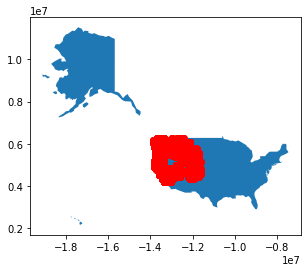Demo: GeoPandas and CRS
Contents
Demo: GeoPandas and CRS#
UW Geospatial Data Analysis
CEE467/CEWA567
David Shean
GeoPandas Background#
Key modules and packages#
Multiple levels of open-source
GeoPandas - high-level vector processing (most of what we’ll do), with dependencies:
shapely (Python interface to
GEOS) https://shapely.readthedocs.io/en/latest/manual.htmlGEOS https://libgeos.org/
Handles geometry, spatial operations
fiona (interface to GDAL/OGR) https://fiona.readthedocs.io/en/latest/README.html
GDAL/OGR https://gdal.org/
File input and output
pyproj (interface to PROJ)
PROJ https://proj.org/
Cartographic projections and coordinate transformations library
numpy
pandas
import pandas as pd
import geopandas as gpd
import matplotlib.pyplot as plt
Load csv as Pandas DataFrame#
glas_fn = '../01_Shell_Github/data/GLAH14_tllz_conus_lulcfilt_demfilt.csv'
glas_df = pd.read_csv(glas_fn)
type(glas_df)
pandas.core.frame.DataFrame
glas_df.head()
| decyear | ordinal | lat | lon | glas_z | dem_z | dem_z_std | lulc | |
|---|---|---|---|---|---|---|---|---|
| 0 | 2003.139571 | 731266.943345 | 44.157897 | -105.356562 | 1398.51 | 1400.52 | 0.33 | 31 |
| 1 | 2003.139571 | 731266.943346 | 44.150175 | -105.358116 | 1387.11 | 1384.64 | 0.43 | 31 |
| 2 | 2003.139571 | 731266.943347 | 44.148632 | -105.358427 | 1392.83 | 1383.49 | 0.28 | 31 |
| 3 | 2003.139571 | 731266.943347 | 44.147087 | -105.358738 | 1384.24 | 1382.85 | 0.84 | 31 |
| 4 | 2003.139571 | 731266.943347 | 44.145542 | -105.359048 | 1369.21 | 1380.24 | 1.73 | 31 |
Convert to GeoDataFrame#
#gpd.GeoDataFrame?
gpd.GeoDataFrame(glas_df)
| decyear | ordinal | lat | lon | glas_z | dem_z | dem_z_std | lulc | |
|---|---|---|---|---|---|---|---|---|
| 0 | 2003.139571 | 731266.943345 | 44.157897 | -105.356562 | 1398.51 | 1400.52 | 0.33 | 31 |
| 1 | 2003.139571 | 731266.943346 | 44.150175 | -105.358116 | 1387.11 | 1384.64 | 0.43 | 31 |
| 2 | 2003.139571 | 731266.943347 | 44.148632 | -105.358427 | 1392.83 | 1383.49 | 0.28 | 31 |
| 3 | 2003.139571 | 731266.943347 | 44.147087 | -105.358738 | 1384.24 | 1382.85 | 0.84 | 31 |
| 4 | 2003.139571 | 731266.943347 | 44.145542 | -105.359048 | 1369.21 | 1380.24 | 1.73 | 31 |
| ... | ... | ... | ... | ... | ... | ... | ... | ... |
| 65231 | 2009.775995 | 733691.238340 | 37.896222 | -117.044399 | 1556.16 | 1556.43 | 0.00 | 31 |
| 65232 | 2009.775995 | 733691.238340 | 37.897769 | -117.044675 | 1556.02 | 1556.43 | 0.00 | 31 |
| 65233 | 2009.775995 | 733691.238340 | 37.899319 | -117.044952 | 1556.19 | 1556.44 | 0.00 | 31 |
| 65234 | 2009.775995 | 733691.238340 | 37.900869 | -117.045230 | 1556.18 | 1556.44 | 0.00 | 31 |
| 65235 | 2009.775995 | 733691.238341 | 37.902420 | -117.045508 | 1556.32 | 1556.44 | 0.00 | 31 |
65236 rows × 8 columns
Looks the same, let’s add geometry column!#
#gpd.points_from_xy?
mygeometry_array = gpd.points_from_xy(glas_df['lon'], glas_df['lat'])
mygeometry_array
<GeometryArray>
[<shapely.geometry.point.Point object at 0x7f19c59ed220>,
<shapely.geometry.point.Point object at 0x7f19c59ed340>,
<shapely.geometry.point.Point object at 0x7f19c59ed190>,
<shapely.geometry.point.Point object at 0x7f19c59ed280>,
<shapely.geometry.point.Point object at 0x7f19c59ed2e0>,
<shapely.geometry.point.Point object at 0x7f19c59ed370>,
<shapely.geometry.point.Point object at 0x7f19c59ed130>,
<shapely.geometry.point.Point object at 0x7f19c59ed1c0>,
<shapely.geometry.point.Point object at 0x7f19c59ed400>,
<shapely.geometry.point.Point object at 0x7f19c5a13370>,
...
<shapely.geometry.point.Point object at 0x7f19aca0c040>,
<shapely.geometry.point.Point object at 0x7f19aca0c0a0>,
<shapely.geometry.point.Point object at 0x7f19aca0c100>,
<shapely.geometry.point.Point object at 0x7f19aca0c160>,
<shapely.geometry.point.Point object at 0x7f19aca0c1c0>,
<shapely.geometry.point.Point object at 0x7f19aca0c220>,
<shapely.geometry.point.Point object at 0x7f19aca0c280>,
<shapely.geometry.point.Point object at 0x7f19aca0c2e0>,
<shapely.geometry.point.Point object at 0x7f19aca0c340>,
<shapely.geometry.point.Point object at 0x7f19aca0c3a0>]
Length: 65236, dtype: geometry
A quick look at Point objects#
type(mygeometry_array[0])
shapely.geometry.point.Point
mygeometry_array[0]
p = mygeometry_array[0]
p
print(p)
POINT (-105.356562 44.157897)
p.x
-105.356562
p.y
44.157897
p.coords
<shapely.coords.CoordinateSequence at 0x7f19ac9eb070>
#list(p.coords)
p.coords[:]
[(-105.356562, 44.157897)]
Assign geometry column to GeoDataFrame#
glas_gdf = gpd.GeoDataFrame(glas_df, geometry=mygeometry_array)
glas_gdf.head()
| decyear | ordinal | lat | lon | glas_z | dem_z | dem_z_std | lulc | geometry | |
|---|---|---|---|---|---|---|---|---|---|
| 0 | 2003.139571 | 731266.943345 | 44.157897 | -105.356562 | 1398.51 | 1400.52 | 0.33 | 31 | POINT (-105.35656 44.15790) |
| 1 | 2003.139571 | 731266.943346 | 44.150175 | -105.358116 | 1387.11 | 1384.64 | 0.43 | 31 | POINT (-105.35812 44.15017) |
| 2 | 2003.139571 | 731266.943347 | 44.148632 | -105.358427 | 1392.83 | 1383.49 | 0.28 | 31 | POINT (-105.35843 44.14863) |
| 3 | 2003.139571 | 731266.943347 | 44.147087 | -105.358738 | 1384.24 | 1382.85 | 0.84 | 31 | POINT (-105.35874 44.14709) |
| 4 | 2003.139571 | 731266.943347 | 44.145542 | -105.359048 | 1369.21 | 1380.24 | 1.73 | 31 | POINT (-105.35905 44.14554) |
glas_gdf.iloc[0]
decyear 2003.139571
ordinal 731266.943345
lat 44.157897
lon -105.356562
glas_z 1398.51
dem_z 1400.52
dem_z_std 0.33
lulc 31
geometry POINT (-105.356562 44.157897)
Name: 0, dtype: object
glas_gdf.iloc[0].geometry
type(glas_gdf['geometry'])
geopandas.geoseries.GeoSeries
type(glas_gdf['lon'])
pandas.core.series.Series
Set CRS#
Right now, we just have x and y values for each point, but no idea what those numbers mean
glas_gdf.crs
glas_gdf.crs = 'EPSG:4326'
glas_gdf.crs
<Geographic 2D CRS: EPSG:4326>
Name: WGS 84
Axis Info [ellipsoidal]:
- Lat[north]: Geodetic latitude (degree)
- Lon[east]: Geodetic longitude (degree)
Area of Use:
- name: World.
- bounds: (-180.0, -90.0, 180.0, 90.0)
Datum: World Geodetic System 1984 ensemble
- Ellipsoid: WGS 84
- Prime Meridian: Greenwich
One-line DataFrame to GeoDataFrame constructor#
The above demonstration was interactive, step-by-step, but can do this in one shot
#glas_gdf = gpd.GeoDataFrame(glas_df, crs='EPSG:4326', geometry=gpd.points_from_xy(glas_df['lon'], glas_df['lat']))
Explore some GeoDataFrame attributes and methods#
glas_gdf.plot();
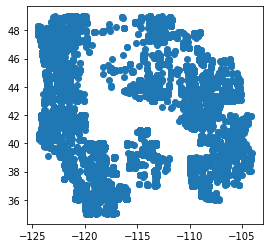
glas_gdf.plot(column='glas_z', legend=True)
<AxesSubplot:>
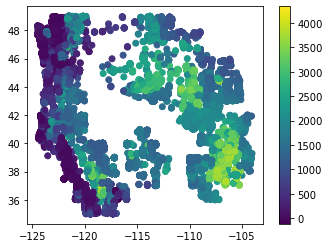
glas_gdf.total_bounds
array([-124.482406, 34.999455, -104.052336, 48.999727])
glas_gdf.geometry
0 POINT (-105.35656 44.15790)
1 POINT (-105.35812 44.15017)
2 POINT (-105.35843 44.14863)
3 POINT (-105.35874 44.14709)
4 POINT (-105.35905 44.14554)
...
65231 POINT (-117.04440 37.89622)
65232 POINT (-117.04467 37.89777)
65233 POINT (-117.04495 37.89932)
65234 POINT (-117.04523 37.90087)
65235 POINT (-117.04551 37.90242)
Name: geometry, Length: 65236, dtype: geometry
#glas_gdf.explore()
Reproject the GeoDataFrame#
#glas_gdf.to_crs?
glas_gdf_proj = glas_gdf.to_crs('EPSG:3857')
glas_gdf_proj.head()
| decyear | ordinal | lat | lon | glas_z | dem_z | dem_z_std | lulc | geometry | |
|---|---|---|---|---|---|---|---|---|---|
| 0 | 2003.139571 | 731266.943345 | 44.157897 | -105.356562 | 1398.51 | 1400.52 | 0.33 | 31 | POINT (-11728238.834 5489909.710) |
| 1 | 2003.139571 | 731266.943346 | 44.150175 | -105.358116 | 1387.11 | 1384.64 | 0.43 | 31 | POINT (-11728411.824 5488711.598) |
| 2 | 2003.139571 | 731266.943347 | 44.148632 | -105.358427 | 1392.83 | 1383.49 | 0.28 | 31 | POINT (-11728446.444 5488472.212) |
| 3 | 2003.139571 | 731266.943347 | 44.147087 | -105.358738 | 1384.24 | 1382.85 | 0.84 | 31 | POINT (-11728481.065 5488232.521) |
| 4 | 2003.139571 | 731266.943347 | 44.145542 | -105.359048 | 1369.21 | 1380.24 | 1.73 | 31 | POINT (-11728515.574 5487992.837) |
glas_gdf_proj.crs
<Derived Projected CRS: EPSG:3857>
Name: WGS 84 / Pseudo-Mercator
Axis Info [cartesian]:
- X[east]: Easting (metre)
- Y[north]: Northing (metre)
Area of Use:
- name: World between 85.06°S and 85.06°N.
- bounds: (-180.0, -85.06, 180.0, 85.06)
Coordinate Operation:
- name: Popular Visualisation Pseudo-Mercator
- method: Popular Visualisation Pseudo Mercator
Datum: World Geodetic System 1984 ensemble
- Ellipsoid: WGS 84
- Prime Meridian: Greenwich
#glas_gdf.plot();
#glas_gdf_proj.plot();
CRS and Projections#
There are many excellent references out there about coordinate systems and map projections. I’m not going to try to reproduce here. If you’re relatively new to all of this, please revisit resources in the reading assignment. Can also review:
I particularly like this poster from the USGS: https://pubs.er.usgs.gov/publication/70047422
Coordinate Reference System (CRS)#
CRS is a “coordinate system with a datum”
AKA Spatial Reference System (SRS): https://en.wikipedia.org/wiki/Spatial_reference_system
Two types:
Geodetic (AKA Geographic)
Projected
How to specify a CRS#
Many ways! https://geopandas.org/en/stable/docs/user_guide/projections.html
EPSG Codes
Proj strings
WKT and WKT2
!gdalsrsinfo EPSG:4326
PROJ.4 : +proj=longlat +datum=WGS84 +no_defs
OGC WKT2:2018 :
GEOGCRS["WGS 84",
ENSEMBLE["World Geodetic System 1984 ensemble",
MEMBER["World Geodetic System 1984 (Transit)"],
MEMBER["World Geodetic System 1984 (G730)"],
MEMBER["World Geodetic System 1984 (G873)"],
MEMBER["World Geodetic System 1984 (G1150)"],
MEMBER["World Geodetic System 1984 (G1674)"],
MEMBER["World Geodetic System 1984 (G1762)"],
MEMBER["World Geodetic System 1984 (G2139)"],
ELLIPSOID["WGS 84",6378137,298.257223563,
LENGTHUNIT["metre",1]],
ENSEMBLEACCURACY[2.0]],
PRIMEM["Greenwich",0,
ANGLEUNIT["degree",0.0174532925199433]],
CS[ellipsoidal,2],
AXIS["geodetic latitude (Lat)",north,
ORDER[1],
ANGLEUNIT["degree",0.0174532925199433]],
AXIS["geodetic longitude (Lon)",east,
ORDER[2],
ANGLEUNIT["degree",0.0174532925199433]],
USAGE[
SCOPE["Horizontal component of 3D system."],
AREA["World."],
BBOX[-90,-180,90,180]],
ID["EPSG",4326]]
!gdalsrsinfo EPSG:32610
PROJ.4 : +proj=utm +zone=10 +datum=WGS84 +units=m +no_defs
OGC WKT2:2018 :
PROJCRS["WGS 84 / UTM zone 10N",
BASEGEOGCRS["WGS 84",
ENSEMBLE["World Geodetic System 1984 ensemble",
MEMBER["World Geodetic System 1984 (Transit)"],
MEMBER["World Geodetic System 1984 (G730)"],
MEMBER["World Geodetic System 1984 (G873)"],
MEMBER["World Geodetic System 1984 (G1150)"],
MEMBER["World Geodetic System 1984 (G1674)"],
MEMBER["World Geodetic System 1984 (G1762)"],
MEMBER["World Geodetic System 1984 (G2139)"],
ELLIPSOID["WGS 84",6378137,298.257223563,
LENGTHUNIT["metre",1]],
ENSEMBLEACCURACY[2.0]],
PRIMEM["Greenwich",0,
ANGLEUNIT["degree",0.0174532925199433]],
ID["EPSG",4326]],
CONVERSION["UTM zone 10N",
METHOD["Transverse Mercator",
ID["EPSG",9807]],
PARAMETER["Latitude of natural origin",0,
ANGLEUNIT["degree",0.0174532925199433],
ID["EPSG",8801]],
PARAMETER["Longitude of natural origin",-123,
ANGLEUNIT["degree",0.0174532925199433],
ID["EPSG",8802]],
PARAMETER["Scale factor at natural origin",0.9996,
SCALEUNIT["unity",1],
ID["EPSG",8805]],
PARAMETER["False easting",500000,
LENGTHUNIT["metre",1],
ID["EPSG",8806]],
PARAMETER["False northing",0,
LENGTHUNIT["metre",1],
ID["EPSG",8807]]],
CS[Cartesian,2],
AXIS["(E)",east,
ORDER[1],
LENGTHUNIT["metre",1]],
AXIS["(N)",north,
ORDER[2],
LENGTHUNIT["metre",1]],
USAGE[
SCOPE["Engineering survey, topographic mapping."],
AREA["Between 126°W and 120°W, northern hemisphere between equator and 84°N, onshore and offshore. Canada - British Columbia (BC); Northwest Territories (NWT); Nunavut; Yukon. United States (USA) - Alaska (AK)."],
BBOX[0,-126,84,-120]],
ID["EPSG",32610]]
Map Projection check in#
Tradeoffs - no perfect projection, all have some distortion of distance, area, direction, shape
Infinite number of ways to represent the Earth’s 3D surface on a 2D Plane
Plane (azimuthal), Cone, Cylinder
Tangent, Secant (intersects sphere at two locations)
Different parameters for different definitions
Center longitude, center latitude
Lines of “true scale”
Proj strings#
mycrs = glas_gdf.crs
mycrs
<Geographic 2D CRS: EPSG:4326>
Name: WGS 84
Axis Info [ellipsoidal]:
- Lat[north]: Geodetic latitude (degree)
- Lon[east]: Geodetic longitude (degree)
Area of Use:
- name: World.
- bounds: (-180.0, -90.0, 180.0, 90.0)
Datum: World Geodetic System 1984 ensemble
- Ellipsoid: WGS 84
- Prime Meridian: Greenwich
mycrs.to_epsg()
4326
mycrs.to_proj4()
#Note warning
/srv/conda/envs/notebook/lib/python3.9/site-packages/pyproj/crs/crs.py:1256: UserWarning: You will likely lose important projection information when converting to a PROJ string from another format. See: https://proj.org/faq.html#what-is-the-best-format-for-describing-coordinate-reference-systems
return self._crs.to_proj4(version=version)
'+proj=longlat +datum=WGS84 +no_defs +type=crs'
glas_gdf_proj.crs.to_epsg()
3857
glas_gdf_proj.crs.to_proj4()
'+proj=merc +a=6378137 +b=6378137 +lat_ts=0 +lon_0=0 +x_0=0 +y_0=0 +k=1 +units=m +nadgrids=@null +wktext +no_defs +type=crs'
proj_str = '+proj=sinu'
glas_gdf.to_crs(proj_str)
| decyear | ordinal | lat | lon | glas_z | dem_z | dem_z_std | lulc | geometry | |
|---|---|---|---|---|---|---|---|---|---|
| 0 | 2003.139571 | 731266.943345 | 44.157897 | -105.356562 | 1398.51 | 1400.52 | 0.33 | 31 | POINT (-8427806.282 4891366.903) |
| 1 | 2003.139571 | 731266.943346 | 44.150175 | -105.358116 | 1387.11 | 1384.64 | 0.43 | 31 | POINT (-8429029.663 4890508.871) |
| 2 | 2003.139571 | 731266.943347 | 44.148632 | -105.358427 | 1392.83 | 1383.49 | 0.28 | 31 | POINT (-8429274.141 4890337.420) |
| 3 | 2003.139571 | 731266.943347 | 44.147087 | -105.358738 | 1384.24 | 1382.85 | 0.84 | 31 | POINT (-8429518.899 4890165.747) |
| 4 | 2003.139571 | 731266.943347 | 44.145542 | -105.359048 | 1369.21 | 1380.24 | 1.73 | 31 | POINT (-8429763.572 4889994.074) |
| ... | ... | ... | ... | ... | ... | ... | ... | ... | ... |
| 65231 | 2009.775995 | 733691.238340 | 37.896222 | -117.044399 | 1556.16 | 1556.43 | 0.00 | 31 | POINT (-10294767.886 4195979.129) |
| 65232 | 2009.775995 | 733691.238340 | 37.897769 | -117.044675 | 1556.02 | 1556.43 | 0.00 | 31 | POINT (-10294576.705 4196150.837) |
| 65233 | 2009.775995 | 733691.238340 | 37.899319 | -117.044952 | 1556.19 | 1556.44 | 0.00 | 31 | POINT (-10294385.184 4196322.879) |
| 65234 | 2009.775995 | 733691.238340 | 37.900869 | -117.045230 | 1556.18 | 1556.44 | 0.00 | 31 | POINT (-10294193.744 4196494.920) |
| 65235 | 2009.775995 | 733691.238341 | 37.902420 | -117.045508 | 1556.32 | 1556.44 | 0.00 | 31 | POINT (-10294002.155 4196667.073) |
65236 rows × 9 columns
Combining Vector Data#
#Grab the bundled world polygons
world = gpd.read_file(gpd.datasets.get_path('naturalearth_lowres'))
world
| pop_est | continent | name | iso_a3 | gdp_md_est | geometry | |
|---|---|---|---|---|---|---|
| 0 | 920938 | Oceania | Fiji | FJI | 8374.0 | MULTIPOLYGON (((180.00000 -16.06713, 180.00000... |
| 1 | 53950935 | Africa | Tanzania | TZA | 150600.0 | POLYGON ((33.90371 -0.95000, 34.07262 -1.05982... |
| 2 | 603253 | Africa | W. Sahara | ESH | 906.5 | POLYGON ((-8.66559 27.65643, -8.66512 27.58948... |
| 3 | 35623680 | North America | Canada | CAN | 1674000.0 | MULTIPOLYGON (((-122.84000 49.00000, -122.9742... |
| 4 | 326625791 | North America | United States of America | USA | 18560000.0 | MULTIPOLYGON (((-122.84000 49.00000, -120.0000... |
| ... | ... | ... | ... | ... | ... | ... |
| 172 | 7111024 | Europe | Serbia | SRB | 101800.0 | POLYGON ((18.82982 45.90887, 18.82984 45.90888... |
| 173 | 642550 | Europe | Montenegro | MNE | 10610.0 | POLYGON ((20.07070 42.58863, 19.80161 42.50009... |
| 174 | 1895250 | Europe | Kosovo | -99 | 18490.0 | POLYGON ((20.59025 41.85541, 20.52295 42.21787... |
| 175 | 1218208 | North America | Trinidad and Tobago | TTO | 43570.0 | POLYGON ((-61.68000 10.76000, -61.10500 10.890... |
| 176 | 13026129 | Africa | S. Sudan | SSD | 20880.0 | POLYGON ((30.83385 3.50917, 29.95350 4.17370, ... |
177 rows × 6 columns
world.crs
<Geographic 2D CRS: EPSG:4326>
Name: WGS 84
Axis Info [ellipsoidal]:
- Lat[north]: Geodetic latitude (degree)
- Lon[east]: Geodetic longitude (degree)
Area of Use:
- name: World.
- bounds: (-180.0, -90.0, 180.0, 90.0)
Datum: World Geodetic System 1984 ensemble
- Ellipsoid: WGS 84
- Prime Meridian: Greenwich
world.geometry
0 MULTIPOLYGON (((180.00000 -16.06713, 180.00000...
1 POLYGON ((33.90371 -0.95000, 34.07262 -1.05982...
2 POLYGON ((-8.66559 27.65643, -8.66512 27.58948...
3 MULTIPOLYGON (((-122.84000 49.00000, -122.9742...
4 MULTIPOLYGON (((-122.84000 49.00000, -120.0000...
...
172 POLYGON ((18.82982 45.90887, 18.82984 45.90888...
173 POLYGON ((20.07070 42.58863, 19.80161 42.50009...
174 POLYGON ((20.59025 41.85541, 20.52295 42.21787...
175 POLYGON ((-61.68000 10.76000, -61.10500 10.890...
176 POLYGON ((30.83385 3.50917, 29.95350 4.17370, ...
Name: geometry, Length: 177, dtype: geometry
world.plot();
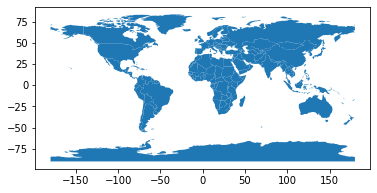
Select a country by name#
idx = world['name'] == 'United States of America'
idx
0 False
1 False
2 False
3 False
4 True
...
172 False
173 False
174 False
175 False
176 False
Name: name, Length: 177, dtype: bool
us = world[idx]
us
| pop_est | continent | name | iso_a3 | gdp_md_est | geometry | |
|---|---|---|---|---|---|---|
| 4 | 326625791 | North America | United States of America | USA | 18560000.0 | MULTIPOLYGON (((-122.84000 49.00000, -120.0000... |
us.plot()
<AxesSubplot:>
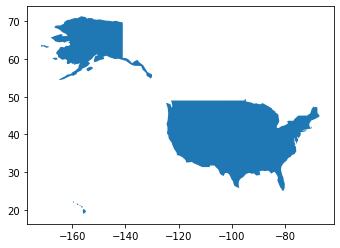
us.crs
<Geographic 2D CRS: EPSG:4326>
Name: WGS 84
Axis Info [ellipsoidal]:
- Lat[north]: Geodetic latitude (degree)
- Lon[east]: Geodetic longitude (degree)
Area of Use:
- name: World.
- bounds: (-180.0, -90.0, 180.0, 90.0)
Datum: World Geodetic System 1984 ensemble
- Ellipsoid: WGS 84
- Prime Meridian: Greenwich
us.geometry
4 MULTIPOLYGON (((-122.84000 49.00000, -120.0000...
Name: geometry, dtype: geometry
Compute area#
us.area
#Note warning!
/tmp/ipykernel_652/4249169899.py:1: UserWarning: Geometry is in a geographic CRS. Results from 'area' are likely incorrect. Use 'GeoSeries.to_crs()' to re-project geometries to a projected CRS before this operation.
us.area
4 1122.281921
dtype: float64
Note: All calculations in GEOS/Shapely are simple euclidian geometry calculations in a 2D cartesian coordinate system!
Use an equal area projection!#
us_cea = us.to_crs('+proj=cea')
us_cea
| pop_est | continent | name | iso_a3 | gdp_md_est | geometry | |
|---|---|---|---|---|---|---|
| 4 | 326625791 | North America | United States of America | USA | 18560000.0 | MULTIPOLYGON (((-13674486.249 4793613.071, -13... |
us_cea.plot()
<AxesSubplot:>
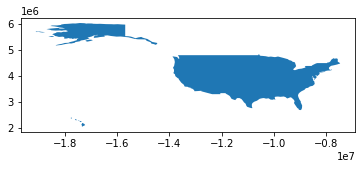
us_cea.area
4 9.509851e+12
dtype: float64
us_cea.area/1E6
4 9.509851e+06
dtype: float64
us_cea = us.to_crs('+proj=tmerc +lon_0=-100')
us_cea.plot()
<AxesSubplot:>
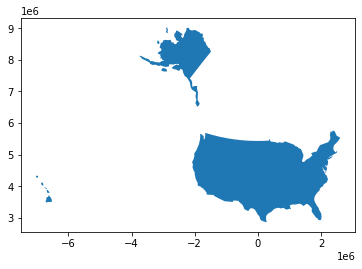
#Back to Web Mercator
#us_cea.explore()
Combining on same plot#
#%matplotlib widget
f, ax = plt.subplots()
us.plot(ax=ax)
glas_gdf_proj.plot(ax=ax, color='r');
#Where are the US polygons? Let's take a look...
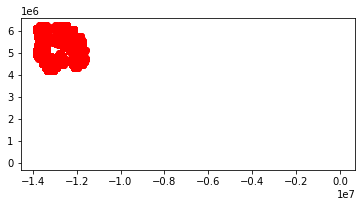
Use a common projection!#
us_proj = us.to_crs(glas_gdf_proj.crs)
us_proj
| pop_est | continent | name | iso_a3 | gdp_md_est | geometry | |
|---|---|---|---|---|---|---|
| 4 | 326625791 | North America | United States of America | USA | 18560000.0 | MULTIPOLYGON (((-13674486.249 6274861.394, -13... |
us_proj.crs
<Derived Projected CRS: EPSG:3857>
Name: WGS 84 / Pseudo-Mercator
Axis Info [cartesian]:
- X[east]: Easting (metre)
- Y[north]: Northing (metre)
Area of Use:
- name: World between 85.06°S and 85.06°N.
- bounds: (-180.0, -85.06, 180.0, 85.06)
Coordinate Operation:
- name: Popular Visualisation Pseudo-Mercator
- method: Popular Visualisation Pseudo Mercator
Datum: World Geodetic System 1984 ensemble
- Ellipsoid: WGS 84
- Prime Meridian: Greenwich
f, ax = plt.subplots()
us_proj.plot(ax=ax)
glas_gdf_proj.plot(ax=ax, color='r');
# Much better!
